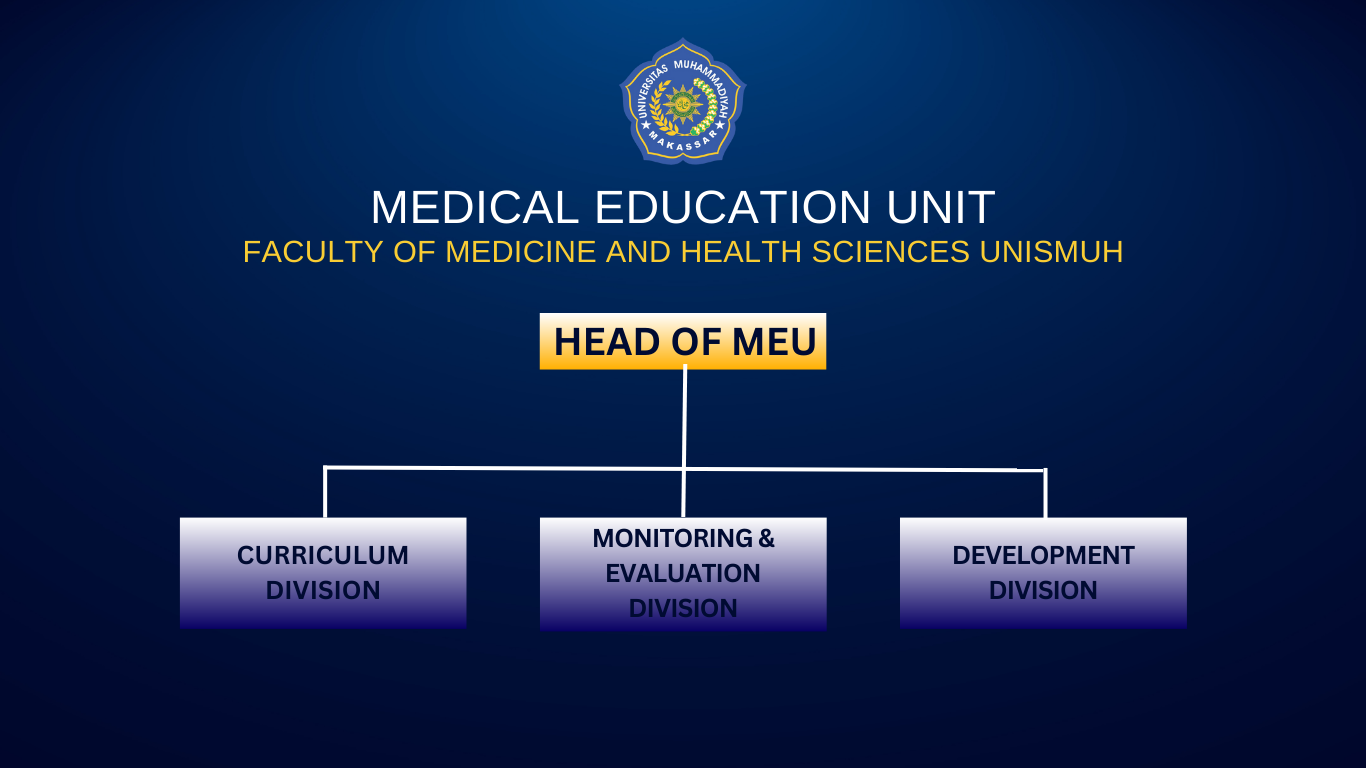Medical Education Unit (MEU)
The Medical Education Unit (MEU) is an independent unit that carries out the tasks of planning, implementing strategies, evaluating, conducting research, and developing curriculum in coordination with the study program.
Duties and Functions of MEU
Duties and Functions of MEU:
-
Development of educational curriculum and academic and professional learning strategies: MEU is responsible for developing educational curriculum and learning strategies for academic and professional stages.
-
Designing curriculum plans for academic stages and implementing curriculum development according to needs: MEU designs curriculum plans for academic stages and ensures the implementation of curriculum development based on identified needs.
-
Conducting and developing educational research: MEU carries out educational research to develop new understanding and knowledge and enhance existing educational practices.
-
Creating teaching implementation strategies in accordance with the implementation of academic and professional curriculum: MEU designs strategies for teaching implementation in line with the implementation of academic and professional curriculum.
-
Human resources development: MEU plans and enhances the competencies of faculty members and educational staff.
-
Designing needs and improving the competencies of faculty members and educational staff: MEU plans the needs and develops competency enhancement programs for faculty members and educational staff in accordance with curriculum and learning strategy developments.
-
Assistance, monitoring, and evaluation of academic and professional curriculum: MEU provides assistance, monitors, and evaluates the implementation of academic and professional curriculum.
-
Collaborating with UPM to monitor and evaluate educational implementation: MEU works together with UPM to monitor and evaluate the implementation of educational programs.
Organizational Structure

Chairperson |
: dr. Ummu Kalzum Malik, M.Med.Ed |
Curriculum DivisionMember |
: dr. Daraugi Aras, M.Kes: dr. Wiwiek Dewiyanti Habar, Sp.KK, M.Kes |
Monev DivisionMember |
: dr. Andi Tenri Padad, M.Med.Ed: dr. Shelly Faradiana, M.Kes, Sp.A |
Development DivisionMember |
: dr. Saldy M, Sp.PD: dr. A. Hendra Yusa, M.Kes, Sp.Rad |
-
Developing curriculum and learning strategies: The MEU Chairperson is responsible for developing the curriculum and designing effective learning strategies for the academic and professional stages.
-
Coordinating with the Heads of Academic and Professional Programs: The MEU Chairperson collaborates with the Heads of Academic and Professional Programs to ensure alignment between the curriculum and program objectives.
-
Supervising activities and implementation of division tasks: The MEU Chairperson oversees the activities and ensures the proper implementation of tasks within the division, providing guidance and support as needed.
-
Reporting MEU activities to the Dean: The MEU Chairperson reports the outcomes and progress of MEU activities to the Dean, providing updates on curriculum development, educational research, and other relevant initiatives.
-
Developing curriculum designs based on SKDI (Indonesian Medical Competency Standards), local content, and strengths: The Curriculum Division is responsible for designing curriculum plans that align with the SKDI and take into account relevant local content and strengths within the context of medical education.
-
Developing implementation plans for the curriculum according to needs: The Curriculum Division designs implementation plans for the curriculum that meet the needs of learners, ensuring that the curriculum can be effectively implemented and achieve the educational goals set.
-
Coordinating with the Student Assessment Unit (SAU) in designing an evaluation system based on the current curriculum: The Curriculum Division collaborates with the SAU to develop an evaluation system that aligns with the ongoing curriculum. This includes designing evaluation instruments, establishing assessment criteria, and ensuring consistency in assessing student learning outcomes.
-
Planning an assessment system that aligns with the curriculum and learning strategies: The Monitoring Division is responsible for planning an assessment system that is in line with the curriculum and the chosen learning strategies. This includes designing assessment methods, determining assessment criteria, and ensuring that the assessment system effectively measures student learning outcomes.
-
Evaluating the assessment system in collaboration with the quality assurance unit: The Monitoring Division works together with the quality assurance unit to evaluate the effectiveness of the assessment system. This evaluation involves analyzing the validity, reliability, and fairness of the assessment methods, reviewing the alignment between assessments and learning objectives, and identifying areas for improvement.
-
Evaluating the curriculum in collaboration with the quality assurance team: The Monitoring Division collaborates with the quality assurance team to evaluate the curriculum. This evaluation process involves assessing the curriculum’s relevance, coherence, and effectiveness in achieving the desired learning outcomes. The division identifies strengths and weaknesses in the curriculum and makes recommendations for improvement based on the evaluation findings.
These tasks ensure the continuous improvement of the assessment system and curriculum, leading to quality education.
-
Conducting research on curriculum development based on curriculum evaluation outcomes: The Curriculum Development Division is responsible for conducting research on curriculum development that is aligned with the findings and outcomes of curriculum evaluations. This research helps identify areas for improvement and informs the development of new curriculum strategies.
-
Developing assessment systems based on evaluation outcomes: The Curriculum Development Division works on developing assessment systems that align with the evaluation outcomes. This involves designing assessment methods, refining assessment criteria, and ensuring that the assessment system effectively measures student learning outcomes.
-
Facilitating collaborative research between faculty members and students: The Curriculum Development Division plays a role in facilitating collaborative research projects between faculty members and students. This collaboration promotes an environment of shared learning and allows for the exploration of new ideas and innovations in curriculum development.
